|
|
|
SADAN BEZEYIS, (President of the Turkish Contemporary Artists Society; Painter and Sculptor), (1926-2017).
Typescript document signed 'Sadan Bezeyis'.
Very Good Turkish Original typescript document signed by Sadan Bezeyis. 28,5x23 cm. In Turkish. 1 p. A member registration receipt including Bezeyis' biographic information, with a title of 'Türkiye Yüksek Heykeltraslar Cemiyeti' [i.e. Turkey High Sculptors Society]. Dated Istanbul, April 22, 1972. A couple of punching holes. Bezeyis was a Turkish painter, sculptor, and the president of the Turkish Contemporary Artists Society. His father is calligrapher, Abdullah Bey. He graduated from Istanbul State Fine Arts Academy High Painting Department Nurullah Berk Workshop, which he started in 1945, in first place in 1951. He represented Turkey at the International Venice Biennale in 1958. Paintings and sculptures of Bezeyis are included in many institutions and private collections in Turkey and worldwide. Turkey High Sculptors Society was founded in 1948.
|
|
|
KAZIM KARABEKIR, (The commander of the Eastern Army of the Ottoman Empire at the end of World War I and served as Speaker of the Grand National Assembly of Turkey), (1882-1948).
[A LIFE GUIDE FOR CHILDREN / BAKU IMPRINT] Ögüdlerim. [i.e. My advices].
Very Good Turkish, Ottoman (1500-1928) Original wrappers. Demy 8vo. (21 x 14 cm). In Ottoman script (Turkish with Arabic letters). [3], 158 p. Occasionally minor age-toning on pages and cover. Spine restored. Uncut and untrimmed copy with sensitive extremities. Otherwise a good copy. First Edition and extremely rare Baku imprint of Karabekir's book including his advices to children, printed in Baku in the same year when the Red Army captured Azerbaijan. Printing types are peculiar to the Caucasus imprints. The author wrote this book in his own words to teach children "the first facts of life". Kâzim Karabekir Pasha, who took care of thousands of children who lost their parents during the First World War, is a statesman and soldier who was also closely interested in the education of these children. "My Advice" book purposes to reach teachers and parents as well as primary and secondary school students. The rights and wrongs that every child should know about life are explained in a sweet way. The book contains more than a hundred moral and other advices on issues such as the importance of being friendly, how to spend money, hospitality rules, spies, paying attention to cleanliness, helping each other, and respecting elders. Musa Kazim Karabekir Pasha was a Turkish general and politician. He was the commander of the Eastern Army of the Ottoman Empire at the end of World War I and served as Speaker of the Grand National Assembly of Turkey before his death. Karabekir was appointed commander of the 2nd Corps on the Caucasian front (Erzurum, Kars, and Baku) and fought bitterly against the Russian and Armenian forces for almost ten months. In September 1917, he was promoted to brigadier general by a decree of the Sultan. OCLC 13180947.; Özege 16062.
|
|
|
[ORIGINAL ALBUMEN PRINT].
[BELGIAN CONGO / HUNTING] [Early photograph showing Joseph DeVos, a Dutch hunter in Belgian Congo, in front of an antelope hunted and hung from the ceiling by the feet].
Very Good Dutch Original albumen print photograph of Joseph Devos, a Dutch hunter in Belgian Congo, showing him in front of an antelope hunted and hung from the ceiling by the feet, with two Congolese natives. 11.5 x 9.5 cm. A handwritten note in Dutch on verso: "Antilope wegende 40 a 50 kilos geschoten 10 November 1911" [i.e. Antelope weighing 40 to 50 kilos shot November 10, 1911], and signed "Joseph Devos". The inscription "Belgian Congo" is seen on the stone. Four pinholes and slight chippings on corners. Overall very good condition.
|
|
|
ANONYMOUS.
[MANUSCRIPT / TULIP OF CONSTANTINOPLE / PENONCUL DE TURQUIE] Çiçek bagçeciligi. [i.e. The flower gardening].
Very Good Turkish, Ottoman (1500-1928) Original notebook in marbling wrappers. Slight chippings on the cover's extremities. Demy 8vo. (21 x 16 cm). In Ottoman script (Old Turkish with Arabic letters) text with Latin titles. [84] blank pages, color, and b/w ills. Scarce, richly illustrated Ottoman and a rare botanical manuscript on gardening, featuring as well the European flower cultivation of Turkish and Middle Eastern flowers. The manuscript starts with an introduction on gardening and floriculture and mentions trees and proper soils, tree and flower planting methods, pine trees, etc. In the "flowers" section, detailed descriptions on floriculture of Daisy, Begonia, Chrysanthemum, Dianthus, Hydrangea, Souvenir de la Malmaison, Oeillet Marguerite, Geant de Nice, Nicotinia, Generaria, Frimula, Calcealaire, Hyacinthus, Istanbul Lâlesi [i.e. Tulip, or Pauble de Constantinople], Albus, Bulbocodium, Bicalor Empress, Bicalor Emperor, Penoncul, Freesia, Ixia [i.e. Lillies], Cyclamen, Glaieul colvillei, Sparaxis, Cycl. Persicum, Iris, Azalea, Giroffe, Lobelias, Meuflia (Snapdragons), Silene, Gloximia, etc. and 19 numbered illustrations which are hand-drawn in color and b/w show the gardening and decorative elements in English and French styles.
|
|
|
ÖZCAN YALTI, (Turkish cartoonist and architect), (1933-).
[Original three autograph caricatures hand-drawn in pen and ink signed 'Yalti'].
Very Good Turkish Original three hand-drawn autograph caricatures signed by Turkish cartoonist Özcan Yalti. (21x15 cm). Dated November 17, 1977. Each includes four types. Özcan Yalti was born in 1933, Istanbul. He was graduated from St. Joseph High School followed by the Faculty of Architecture of Istanbul Technical University in 1962. He began to draw caricatures in 1963. His meeting with Turhan Selçuk paved the way for his caricatures to be published in Turkish newspapers. He drew for Yeni-Dergi, Cumhuriyet, Pardon and Akbaba periodicals and journals. He worked as an architect for the Ministry of Public Works in Ankara. (Source: 50 yilin Türk mizah ve karikatürü, BALCIOGLU-ÖNGÖREN).
|
|
|
ERNST ARNOLD EGLI, (Austrian architect), (1893-1974).
[AUSTRIAN ARCHITECT OF THE YOUNG TURKISH REPUBLIC] Typescript letter signed 'Profesör Egli'.
Very Good Turkish Original typewritten letter written in response to questions about some interior decorations and curtains during the construction of a Republican Turkish school, signed 'Professor Egli'. 30x23 cm. In Turkish (Modern). 1 p. Chipped and damaged right side. Otherwise a good paper. Written to 'Zeki Bey' on December 21, 1933. An architectural environment of the Early Republic Period (1923-1950) has an effective language explicitly revealing political and cultural aspects of the Republic. Under such conditions, architects coming from German-speaking countries contributed quite significantly to the establishment of the International Architectural Style of Turkey in the '30s. Throughout the 1930s when the Building of School Political Sciences constituting the subject of the study was constructed, the International Architectural Style conveyed to Turkey by means of architects coming from Germany-speaking countries had a growing impact in the country. Ernst Egli, one of those architects, was one of the pioneers of this "modern" style with his numerous designs, and his educator and manager identity. Egli, son of Johann Jakob Egli, (1840-1918) carried out significant works in the field of educational buildings which he dealt with cautiously and fastidiously and explicitly regarded as a symbol of prestige. Primarily educational buildings together with National Education Ministry Construction Office management, Istanbul Fine Arts Academy Architecture Branch management, and teaching, design, and application of important public buildings in Ankara are among the said studies. (An important building for the representation of modernization project: Swiss architect Ernst Arnold Egli and Ankara Political Sciences School, Leyla Alpagut.).
|
|
|
[LIBRARIAN OF YILDIZ PALACE LIBRARY].
[HAFIZ-I KÜTÜB: OTTOMAN LIBRARIANSHIP - PALACE LIBRARY] Ottoman manuscript document including notes on types of rare books, photograph albums and their languages, "Library of HM, Yildiz Palace" letterhead.
Very Good Turkish, Ottoman (1500-1928) Original manuscript document including notes the types and numbers of the rare books, photo albums and their languages, probably taken by the royal librarian of the Ottoman Yildiz Palace in the period. 21,5x13,5 cm. In Ottoman script (Old Turkish with Arabic letters). 1 p. No signature. Letterhead of "Yildiz Sarayi Alîsi Kütübhâne-i Hümâyûn-i Cenâb-i Mülûkâne" [i.e. Library of HM, Yildiz Palace].
|
|
|
EDIB SALIM, BAHRIYE = EDIB SALIM, NAVY.
[OTTOMAN TRADE - SEAMAN MERCHANT] Ottoman manuscript law document.
Very Good Turkish, Ottoman (1500-1928) Original manuscript law document, with bilingual letterheads on the paper as "Edib Salim, Bahriye" in French and Ottoman script. 27x21 cm. 2 p., 17 lines, full. Ottoman stamps (Mortar and airplane) and seals, signed by the merchant. In Ottoman script (Old Turkish with Arabic letters). The application of the debtor of Merchant Edip Salim, named Hüseyin Hüsnü, to the 3rd Notary Public of Eminönü to issue a warning for the deed he has not paid. Dated July 22, 1928.
|
|
|
CAHIT UÇUK, [Pseudonym of Cahide Üçok], (Turkish female author), (1909-2004).
[ARCHIVE OF PIONEER FEMALE WRITER WITH A MALE PSEUDONYM] Autograph archive of Cahit Uçuk including her manuscripts of stories, nursery rhymes, tales, fables, letters, and newspaper clippings and stores serialized in the periodicals with her autograph corrections and notes.
Very Good Turkish, Ottoman (1500-1928) A large and fine collection and archive of Cahit Uçuk, (1909-2004) including various size clippings, a caricature, her biography, news, her serialized stories published in Turkish periodicals, and newspapers with several autograph corrections by Uçuk (Serialized novels include approx. 65 p., two are complete) as well as her original autograph - manuscript letter, manuscripts titled "Televizyon için notlar" [i.e. Notes for Television] (40 paged), a compilation of Turkish nursery rhymes (17 pp.), stories, fables, and fairy tales, and her population register document (it seems he was born in Diyarbakir city contrary to what is known as Istanbul, or Thessaloniki [Salonica] according to this document), manuscript report of her interview made by Hikmet Altinkaynak (1945-), and an essay titled "Yunanlilar'a Mektup" [i.e. A letter to Greeks]; and her plan for a journey to Italy. Cahit Uçuk was a Turkish female author and story writer. Ibrahim Vehbi Üçok, whose father was the Siverek Deputy and District Governor in the last Ottoman Parliament, and her mother was Hadiye Hanim, who was originally from Thessaloniki. Cahit's first tale was published in the magazine named "Yarim Ay" [i.e. Half Moon] published by Nâzim Hikmet in 1935. Mrs. Cahit, who also wrote poetry before, turned to story and novel writing. In her works, she mostly dealt with women's rights and the place of women in society, and occasionally worked on mystical themes. She's famous for her children's books. Many female writers have adopted male noms-de-plume, or otherwise gender-ambiguous pseudonyms, for a number of reasons: to publish without prejudice in male-dominated circles; to experiment with the freedom of anonymity or to encourage male readership. Cahit Uçuk, in his memoirs about the difficulties of being a woman writer in the world of men, could not keep a secret behind the name that everyone thought belonged to a man, and Bab-i Âlî [i.e. the street in Istanbul where publishers gathered in the Ottoman Empire] soon learned that she was a very beautiful woman.
|
|
|
NEVIN [MELIKE] PERTEV DEMIRHAN, (1910-1969?).
[INTERESTING ARCHIVE OF AN INTELLECTUAL OTTOMAN/TURKISH WOMAN] [A manuscript diary, letters to and from, documents, notebooks of an intellectual late Ottoman/early Republican woman].
Very Good Turkish, Ottoman (1500-1928) The collection includes one full diary, 4 notebooks, 120 letters addressed to Nevin Pertev Demirhan and Meryem Ana Efes ruins photo negatives in an envelope, and ID cards, court documents of Demirhan family (Father Pertev Pasha, brother Ömer Ilhan Demirhan, and mother Hatice Leman Demirhan). 4 notebooks of her from "English High for Girls, Constantinople" including the lessons of dictation, rough notebook, setback, essays, and letters. All notebooks are in English. Also, there are letters addressed to Fatma Behçet Hanim. Diary includes [336] p. with full of writings between the dates August 4, 1955 (Thursday) and November 24, 1955 (Thursday). This collection contains an Ottoman / Turkish intellectual woman's political thoughts, social life, travels, recipes, and friendships in a short time in 1955. A hardcover manuscript diary and letters to and from her. Letters have very interesting correspondences in the mostly Ottoman script as well as in modern Turkish, English, French, and German. One of the letters addressed to her (Ömer Ilhan Demirhan's letter) and some others include very interesting thoughts about women and femininity. Ömer Ilhan told her that he wants to be married and that did not find a suitable wife for himself. Some of the letters in this collection like that have very important and interesting hints for "Turkish women". Letters dated usually from the 1930s to the 1950s. Nevin Pertev Demirhan was an intellectual and translator as well as pianist according to 'Türkischer Biographischer Index'. She translated her father's book titled 'Islam' into English with her father. Her father was Sait Pertev Demirhan who was an important Turkish soldier, intellectual, and politician.
|
|
|
SÜKRIYE SERAFEDDIN, (Ottoman princess, The daughter of Prince Yusuf Izzeddin Efendi), (1906-1972).
Autograph letter signed 'Sükriye Serafeddin' to an unnamed recipient.
Very Good Turkish, Ottoman (1500-1928) Original autograph letter signed (ALS) by Ottoman princess 'Sükriye Serafeddin'. 17,5x14,5 cm. In Ottoman script (Turkish with Arabic letters). 1 p. [in four]. Bifolium. The letter starts with 'Huve' and it has 12 lines. She mentions a letter that was sent by this unnamed recipient to 'Serafeddin' who is probably from the Ottoman dynasty. Sükriye Sultan was an Ottoman princess, the daughter of the heir to the throne Sehzade Yusuf Izzeddin, son of Sultan Abdulaziz, and Leman Hanim. Sükriye Sultan was born on 24 February 1906 in Çamlica Palace. Her mother was Leman Hanim. She was the second child, and eldest daughter born to her father and the eldest child of her mother. She had two younger siblings, a brother, Sehzade Mehmed Nizameddin, two years younger than her, and a sister, Mihrisah Sultan, ten years younger than her. She was the granddaughter of Abdulaziz and Dürrünev Kadin.
|
|
|
ADALET AGAOGLU, (Turkish author), (1929-2020).
Autograph letter signed 'Adalet' addressed to Samira Akmen, with its envelope.
Very Good Turkish Original manuscript autograph letter on-card signed by Adalet Agaoglu. (8,5x12,5 cm). In Turkish. 2 p. Includes 28 lines. Repaired in its period by tape. Blue ink on paper. Dated 'March, 26, 1982'. Adalet Agaoglu is a female Turkish novelist and playwright. She is considered one of the foremost novelists of 20th-century Turkish literature. She has also written essays, memoirs, and short stories. As an author, a playwright, and a human rights activist, she became one of the most prized novelists of Turkey. Considered to be one of the most important living authors in Turkey a revered intellectual, her tightly constructed prose is a balance between a realistic milieu of Turkey which she knows firsthand and the broader, more humanistic elements of social pressure and gender prejudice. In an unfamiliar urban world, her fictional newcomers to modernity struggle with age-old issues complicated by perplexing political, religious, economic, and social forces. She has been rewarded with numerous honors besides the literary awards she won in the fields of the novel, short story, and drama. For her perception of subtle and overt changes in modern Turkish society and her writing entitled "Modernism and Social Change", Adalet Agaoglu received the "Turkish Presidency Merit Award" in 1995. In 1998, Agaoglu received an "Honorary Ph.D." from Anadolu University followed by the "Ph.D. of Humane Letters" from Ohio State University.
|
|
|
SÜKRIYE DIKMEN, (Turkish female painter), (1918-2000).
Autograph letter signed 'Sükriye', telling her trip in Yalova city with her father Cafer Fahri Bey, Celal Sofu, Refet Pasha and Fazil Bey, sent to Turkish paintress Fatma Tiraje Dikmen, (1925-2014).
Very Good Turkish Original manuscript autograph letter signed by Turkish female painter Sükriye Dikmen, addressed to her sister Tiraje Dikmen who was a painter as well. On a paper with letterhead 'Molvan Müesseseleri Termal Otel in Yalova' and watermarked 'Extra Strong'. 2 p. She mentions a trip to Yalova and its villages with her father Cafer Fahri Bey, Celal Sofu (Melek Celal Lampe's husband), Refet Pasha, Fazil Bey, and what a clever man Refet Pasha is when he speaks especially (like a devil!). She wants a corset from her sister. Sükriye Dikmen was a Turkish female painter who is known for her portraits of women and young girls. She was born in Istanbul in 1918. Her father was Cafer Fahri Bey of Batum, a scientist of the Republican era. She is the older sister of painter Tiraje Dikmen, and the nephew of Ali Dikmen, a member of the Ottoman parliament Meclis-i Mebusan, and later a member of the Grand National Assembly. Dikmen received her pre-university education at the Robert College in Arnavutköy finishing in 1942. Six years later in 1948, she completed her education at the Painting Department of the State Academy of Fine Arts Istanbul, and then went to Paris, France. In 1953, she graduated from the Art history Department of the Ecole du Louvre in Paris and worked three years with Fernand Léger and two years with Sengier Chastel and Roger Chastel. In 1953, she opened her first solo exhibition, and the next year she had her first solo exhibition in Turkey. In 1957, Dikmen participated in the exhibition of a contemporary Turkish art exhibition in Edinburgh, Scotland, and then in similar exhibitions during 1962 in Paris, Brussels, and Vienna. In 1968, she organized a retrospective exhibition gathering both her old and new works.
|
|
|
SIBTU'L-MARDINÎ [BADR AL-DÎN MUHAMMAD B. MUHAMMAD B. AHMAD AL-MARDÎNÎ], (Egyptian mathematics and astronomy scholar), (1423-1493).
[ASTRONOMY - MATHEMATICS - ARABIC MANUSCRIPT: JAYB & MUQANTARÂT; SINUS & ALMUCANTAR QUADRANT] Hadhâ risâle-i rüb'u mukantarât, Hadhâ risâle-i cenûb taraf, Hadha mukharrar latashich al-shaat fî taraf al-cayb min al-rub'u' mu'âl-ihtizâr.
Very Good Arabic Original manuscript without binding. 12mo. (16 x 11 cm). In Arabic. [40] p., drawings, and tables. Marginal texts additionally. A linear wormhole on the bottom from beginning to the end, the thread in the spine is broken hence two separate parts. Otherwise a good copy. Rare manuscript compiled from works related to astronomical instruments written by probably Sibtu'l-Mardînî, copied anonymously in the early 19th century on the paper with 'ahar' with four marginal drawings and tables. The copier of this manuscript is not described. An 'Ebced' notes on the last blank page. The manuscript starts with a calendar in the Islamic system which is prepared with red and black inks and annotated info around the table. The first part includes how to use an almucantar, directions on the sphere, location of the stars in the sky. On the last two pages, the author describes the preparation of an almucantar. The second part is titled "Hadhâ risâle-i cenûb tarafi" [i.e. Tractate on the South direction], and the third and last part titled " Hadhâ risâle-i cenûb taraf, Hadha mukharrar latashich al-shaat fî taraf al-cayb min al-rub'u' mu'âl-ihtizâr", includes some 'sinus mathematics' with two impressive tables on the opposite page. Sibt al-Maridini, the full name Muhammad ibn Muhammad ibn Ahmad ibn Muhammad ibn al-Ghazal (1423-1493), was an Egyptian-born astronomer and mathematician. His father came from Damascus. The word "Sibt al-Maridini" means "the son of Al-Mardini's daughter". His maternal grandfather, Abdullah al-Mardini, was a reputed astronomer of the eighth century AH. He was a disciple of the astronomer Ibn al-Majdi (d. 850/1506). Sibt al-Mardini taught mathematics and astronomy in the Great Mosque of al-Azhar, Cairo. He was also a timekeeper (muwaqqit) of the mosque. He wrote no fewer than fifty treatises in astronomy (sine quadrants, sundials, astronomical tables, and prayer times) and wrote at least twenty-three mathematics textbooks. Al-Sakhawy counted two hundred books that were written by Sibt al-Mardini, on Islamic law, astronomy, and mathematics. Libraries that specialize in ancient manuscripts, all over the world, have transcripts of his works. Sibt al-Mardini's declared that "the opinion of the muezzins (those who call people to prayer) is less correct than that of the legal scholars and it is the latter that should be used as the basis for the determination of prayer time". (Wikipedia). Sib? al-Maridini was a prolific author of astronomical texts, which were still being used and studied into the 19th century. Little is known with certainty about his life. It is thought that he grew up in Damascus, where his maternal grandfather, Abd Allâh ibn Khalîl ibn Yûsuf Jamâl al-Dîn al-Mâridînî (died: 1406), was the muwaqqit (timekeeper) in charge of regulating the daily rituals of the Islamic community) of the Umayyad Mosque. Later he traveled to Cairo, where tradition places him as a student of Ibn al-Majdî. Sib? al-Mâridînî wrote extensively on mathematics and mathematical astronomy. Like his grandfather, he was especially interested in astronomical instruments. The bio-bibliographical sources list some 25 treatises, many of which exist today in multiple copies. According to the historian al-Jabarti (died: 1822), Sib? al-Mâridînî's works on mîqât (ritual timekeeping) and astronomical instruments were still being studied in the curriculum of Cairo's al-Azhar, one of the preeminent educational institutions in the Islamic world, at about the beginning of the 19th century. (Biographical encyclopedia of astronomers, 2007).
|
|
|
ÇANKAL-ZÂDE HOCA EBÛBEKIR NUSRET EFENDI HARPUTÎ, (?-1794).
[MANUSCRIPT / MEDICINE / MAGIC: 18TH CENTURY MEDICINE FROM AN OTTOMAN POET] Kitâb-i Ebûbekir Nusret Efendi [Mâ-hazar - Mücerrebât-i Nusret - Nusret Efendi mecmuasi]. Copied and annotated with the names of drugs by Hafiz Ali b. Ebûbekir (Izâfi'l-Gafurü'l-Hakîr).
Very Good Turkish, Ottoman (1500-1928) Contemporary (early 19th century) quarter brown cloth with marbled boards, "Yahudi ebrûsu" end-papers. Roy. 8vo. (23 x 16 cm). In Ottoman script (Old Turkish with Arabic letters). 90 p., numbered with Arabic numeric system in pencil, around seven illustrated schemes of magical diagrams. Written on a probably 17th-18th century European paper with "Crescent" watermark, naskh script with "harakât", black and red ink. Early and a rare posthumous manuscript copy of this 18th-century Islamic majmua, containing the treatment methods and drug compositions against physical and spiritual diseases, with material and magical suggestions, copied 32 years after the author's death by a "Hafiz" with an addendum of new drugs and treatments compiled from older annotations of this work. "In the first part of the work on spiritual medicine, verses, prayers, talismans, and magic formulas in the Islamic culture like "wafqs" that are believed to be treated; in the second part, on physical medicine, drug formulas from various material objects for physiological diseases are shown." (Çagrici). Harputî was an 18th-century poet and prose from Harput (Kharberd). In the introduction to the manuscript, he stated that he is not a doctor, but that he writes practices that can heal patients due to his experiences. Despite this, the text was widely used in Ottoman medicine in the 18th and 19th centuries.
|
|
|
Harry (Myriam)
Deux billets autographes signés.
Première lauréate du prix Femina, créé pour elle en réaction au refus des Goncourt, de lui accorder la distinction pour laquelle elle avait été pressentie. Grande voyageusen née à Jérusalem, Myriam Harry, née Marie Rosette Shapira, était la fille de Guillaume Moses, juif converti au protestantisme.
|
|
|
Caspar Willy STREIFF [mit Brief und Widm.]:
Dramatische und neue lyrische Dichtung.
Widmungsexemplar dieser Sammlung mit Gedichten (beinhaltend die Zyklen "Gesänge an Böcklin", "Griechische Elegien", "Gesänge an Segantini" und "Eigene Welt" bzw. einer szenischen Arbeit ("Gallische Priesterin") des in Basel wirkenden Lyrikers Caspar Willy Streiff (wohl nicht zu verwechseln mit dem Glarner Mundartautor Caspar Streiff (1853-1913). Auf dem Innenteil der Vorderseite ist ein zweiseitiger, eigenhändiger Brief des Verfassers vom 14. Mai 1918 an einen "Dr. König sen. Schönbühl" eingeklebt, der gebeten wird, über seinen Freund, Streiffs Schwiegervater Bendict Glauser, einem Wagner in Fraubrunnen, Auskunft zu geben, da der Autor ein "Lebensbild" Glausers zeichnen will. Auf dem Titelblatt widmet Streiff das Exemplar zusätzlich "Herrn Dr. König sen. in Dankbarkeit Caspar W. Streiff". – Umschlag an den Ecken und Kanten berieben und etwas bestoßen, Titelblatt und hinterer Vorsatz stockfleckig, sonst sauberes Exemplar dieses von der Buchdruckerei Haller in Burgdorf auf festem Maschinbütten gefertigten Privatdrucks; ein interessantes familiengeschichtliches Dokument.
|
|
|
HAJEK, Egon:
Wanderung unter Sternen. Erlebtes, Erhörtes und Ersonnenes. Umschlag und Einband von Erwin Maier. Mit einem Frontispiz nach einem in der Platte signierten Porträtfoto des Autors.
Widmungsexemplar dieser Autobiographie des aus dem Siebenbürgischen Kronstadt (Bra?ov, Rumänien) gebürtigen evang. Theologen Egon Hajek (1888-1963), Musikschriftsteller und produktiver Literat (u.a. Gedichte, Novellen und Romane). Hajek war 1927 nach Wien übersiedelt, wo er neben der Leitung der Pfarre Währing und der Gründung bzw. Führung der Wiener Bach-Kantorei auf universitärer Ebene auch Musik und evangelische Theologie lehrte. Mit neunzeiliger, signierter und datierter Widmung des Autors auf dem vorderen Vorsatz an den ehemaligen Austrofaschisten, Widerständler gegen die Nazis und hochrangigen ÖVP-Politiker Alois (Lois) Weinberger (1902-61): "Seiner Exzellenz / Herrn Minister a. D. / Alois Weinberger / Vizebürgermeister / ergebenst u. dankbarst / überreicht / vom Verfasser / Egon Hajek / Wien, den 19. XI. 58". – Kosch VII, 164; Sutter, Siebenbürger Sachsen in Österreichs Vergangenheit und Gegenwart, 1976 zit. nach DBA 3.0343.051 (Hajek); Czeike, Historisches Lexikon Wien, Bd. 5, 1997 zit. nach DBA 3.0974.448 (Weinberger).
|
|
|
[TEGETTHOFF, Wilhelm von]; HARTMANN, Carl:
Die Wunder der Erdrinde. Gemeinfaßliche Darstellung der Geologie und Mineralogie. 2 Aufl. Mit 384 Abb. auf 24 lithograf. Taf.
Zweite Aufl. des zuerst 1838 erschienenen, umfangreichen geologischen und mineralogischen Fachbuchs des deutschen Mineralogen, Hütteningenieurs und Fachschriftstellers Carl Friedrich Alexander Hartmann (1796-1863), im Titel als »Seitenstück« zur 5. Aufl. von Hoffmanns im gleichen Verlag veröffentlichten Handbuch »Die Erde und ihre Bewohner« angekündigt. Die kräftig und sauber lithografierten Tafeln zeigen die Eisschmelze auf Gletschern, Vulkanausbrüche, fossile Funde (Tierknochen, Muscheln, Schnecken), die Krystallographie von Mineralien, Illustrationen zum Behelf der angewandten Geologie für Ackerbau, die Errichtung von Bergwerken, Straßen, Kanälen, Brunnen etc. - Vorliegendes Exemplar stammt ursprünglich aus dem Besitz des Kommandanten der österreichisch-ungarischen Kriegsmarine, Vizeadmiral Wilhelm von Tegetthoff (1827-71). Auf dem vorderen Vorsatz recto befindet sich der mit Tinte geschriebene Namenszug Tegetthoffs, und auch ein Vorbesitzer, ein Neffe von Tegetthoffs Vertrautem Georg Ritter von Leitgeb, weist in einem auf der Innenseite des Vorderdeckels eingeklebten, mit Bleistift verfassten dreiseitigen Brief, der an einen mit diesem Exemplar im Jahr 1906 beschenkten »Herbert« gerichtet ist, auf diesen Umstand hin: »Das Ihnen mit d. Post gesandte Buch hat mein Onkel Oberst Georg v. Leitgeb als ex Kommandant der Marine-Artillerie vom Admiralen Tegetthoff erhalten. Tegetthoff war mit uns. Familie eng befreundet & habe ich das Buch nach dem Tod des Onkels geerbt. Auf der ersten Seite finden Sie den eigenhändigen Namenszug des Admirales.« Oberstleutnant Georg Ritter von Leitgeb war erfolgreicher Kommandant der Strandbatterie bei der italienischen Blockade von Triest (1848) und der Marine-Artillerie bei der Verteidigung von Venedig (1859) gewesen, gehörte später dem Generalstab an, und wurde schließlich von seinem Freund Tegetthoff als Professor für Mathematik und Physik an die Marine-Akademie von Triest bzw. Fiume berufen. - Lederrücken stellenweise gebrochen, abgesplittert und berieben, Einbandeckeln etwas berieben, teils gering stockfleckig, insgesamt gut erhaltenes Exemplar dieses Werks, mit einer militärhistorisch äußerst interessanten Provenienz. - Zimmermann, Franz X.: Otto von Leitgeb. Eine Studie. In: 61. Jahresbericht über das Schuljahr 1910-1911 des Staatsgymnasiums in Görtz. Görtz: Selbstvlg. 1911, Ss. 2-91, hier: S. 9f. (zu Leitgeb).
|
|
|
WILHELMI, Adolph:
Dmitri Iwanowitsch. Drama.
Erstausgabe, mit eigenhändiger, vierzeiliger, datierter und signierter Widmung des Autors. Höchstwahrscheinlich handelt es sich beim Verfasser um Ludwig Adolph Wilhelmi von Mosbach (1818-96), von 1853-61 großherzoglicher Stadtdirektor von Heidelberg: "To the philosophical child / dedicated by the author. / Baden-Baden. / Sept. 1869." - Hintergelenk geplatzt und am Kopf mit einer kleinen Fehlstelle, Papier gebräunt, sonst sauber. (Copyright Domenico Jacono. Verwendung der Titelaufnahme oder von Teilen daraus nur mit ausdrücklicher Genehmigung.)
|
|
|
Wieland SCHMIED; Paul ELIASBERG:
Worte für Worte. 1. Tausend. Ausstattung von Horst Heiderhoff. (= Das neueste Gedicht, 8).
Erstausgabe dieses Gedichtbändchens des vor allem als Kunstkritiker namhaften Wieland Schmied, mit einer datierten und signierten Widmung des Autors an den 1983 verstorbenen, deutschfranzösischen Grafiker Paul Eliasberg, dessen Arbeiten Schmied immer wieder essayistisch begleitete (z. B. Radierungsfolge “Weg ins Ungewisse”, 1966). - Rücken geringfügig gebräunt, sonst sehr sauberes Exemplar. - Wilpert/Gühring, 2. Aufl., Pos. 13.
|
|
|
Unleserlich [VERFASSER]; Johann Baptist BOLZA. Freiherr von. Truchsess (vermutl. Finanzbeamter) am Hof Maria Theresias [GEGENZEICHNUNG]:
Schriftstück der K.k. Hofkammer an die Banater Landesadministration betreffend der Bezahlung von Medikamenten für erkrankte Kolonisten. Unterschrift und Gegenzeichnung, Papiersiegel mit blindgeprägtem kaiserlichem Wappen und Adressierung.
Das Temescher Banat war nach der Eroberung durch Habsburgische Truppen unter Führung von Prinz Eugen von Savoyen im Jahr 1718 bis 1778 eine direkt dem Herrscherhaus gehörende Kron- und Kammerdomäne. Das Gebiet wurde von der Banater Landesadministration verwaltet, die in Geldangelegenheiten der Wiener Hofkammer, der zentralen Finanzbehörde der Monarchie, unterstellt war. Kolonisten aus verschiedenen Teilen der Monarchie waren zur Urbarmachung des teils sumpfigen Landstrichs angesiedelt worden. Viele davon erkrankten vor allem an Malaria, weshalb die Sanitätskommission der Banater Landesverwaltung Apotheken einrichten und auf Kosten der Hofkammer Medikamente verabfolgen ließ. Im Hof-Schematismus auf 1773 wird der vorliegendes Schriftstück gegenzeichnende Johann Baptist Freiherr von Bolza als Truchseß aufgeführt. Sein Bruder Johann Peter war seinerzeit einer der höchsten Finanzbeamten des Hofs. - Transkription des Texts: „Von der römisch. Kais. Zu Hungarn und Böheme / Königl. Majestät Erzherzogin zu Österreich u. Ungarn / Allergnädigsten Frauen wegen: dero Temeswarer / Landes Administration hiermit /somit (?) in Gnaden anzuzeigen: / Sie thr… (?) die mittels Berichts von 4 ten Sept.: Einge- / Reichte hier wieder zurückfolgende Aufträge des / Apotheker Praticens zu Temeswar Bernardin (?) Koell / Über die für die erkrankten Kolonisten verabfolgte / Medicamenten in einem Betrag zu 1400 Fl 54 ¼ Kr. Von der / Daruntigen Buchhaltung schon adjustiert worden, so / Mag es hierbey für diesmal freiverblieben haben / Und himmit die Erlaubnis ertheilet, daß der dies- / Fällige Betrag zu: 1400 Fl 54 ¼ Kr. Gehörig gezahlet / Werden möge; Künftig sei aber und dergleichen / Apotheker Conti nicht nur von den daruntigen / Medico einzusehen, und zu verifizieren, sondern auch / Von der dortuntigen Buchhaltung zu adjus- / Tieren, und der dortuntigen bestehenden / Apotheker Tag-Ordnung zur weiteren Einsicht / Und Beurtheilung anher zu senden. … mach / Sie Administrataen sich zu achten, und das nöthige / Zu Verfügen haben wird. Und es verbleiben / Übrigens allerkhöchst gedacht Ihro Majestät / Derselben mit k. k. und erzherzöglichen Gnaden / Wohlgewogen. Signatum Wien unter allerhöchst / Deroselben beygedruckten Secretensiegel den / 3ten Monats Tag Novembris im Siebenzehn- / Hundert drey und Siebzigsten Jahren. / (Unterschrift des Verfassers, unleserlich).“ - Blatt stellenweise mit Wasserflecken und mit leichtem Pilzbefall, einige spätere Besitzervermerk und einem Besitzerstempel (rumän. Privatbibliothek). Insgesamt gut erhaltener Bogen mit hübsch kalligrafierter Initiale und Titelzeile. - K.k. Staats- und Standeskalender auf das Jahr 1773, S. 449; zu Joh. Bapt. Bruder: Artikel „Bolza, Johann Peter Freiherr von“ von Joseph Kürschner in: Allgemeine Deutsche Biographie, herausgegeben von der Historischen Kommission bei der Bayerischen Akademie der Wissenschaften, Band 3 (1876), S. 116, Digitale Volltext-Ausgabe in Wikisource, URL: https://de.wikisource.org/w/index.php?title=ADB:Bolza,_Johann_Peter_Freiherr_von&oldid=2489841 (Version vom 13. September 2017, 20:55 Uhr UTC)
|
|
|
Kurt Erich ROTTER; Stephan SZABO (Augarten-Verlag):
Teilnachlass bestehend aus 8 Einheiten: 1 - Album »KER 9« (1978), u.a. mit teils hs. u. ms. Texten, Korrespondenz und Originalfotografien. 2 - Gästebuch (1929-1944). 3, 4 u. 5 - 2 Mappen mit illustrierten bibliophilen Druckproben, davon eine mit orig. Kunstwerk; 1 Mappe mit 3 Urkunden, u.a. über die Verleihung des Goldenen Verdienstzeichens der Republik Österreich. 6 - Widmungsexempar des Gedichtbands »Bilder einer Ausstellung« (1973); 7 - 2 Kupferplatten für Visitkarten der Wiener Fa. Huber & Lerner und 8 – 1 Parte des Augarten-Verlags.
Teilnachlass des österreichischen Lyrikers, Romanciers und Erzählers Kurt Erich Rotter (1907 Hadersdorf – 1979 Wien), dessen erster Lyrikband 1926 erschien, und der in 45jähriger Kooperation mit dem Wiener Augarten-Verlag von Stephan Szabo insgesamt „12 Gedichtbände, 2 Romane und 2 Bände Aphorismen“ (Parte) herausgebracht hat. Rotter fungierte von 1932-38 auch als königl. rumänischer Honorar-Vizekonsul für Kunst- und Literaturagenden und bekleidete einen führenden Posten in der Wiener Handelskammer. Er erhielt u.a. das Goldene Verdienstzeichen der Republik Österreich, war Mitglied des Lazarusordens und Ehrenmitglied der Accademia Tiberiana in Rom. Inhalt: 1. Album »KER 9« mit eigenen hs., ms., sowie gedruckten (und als Ausschnitte montierten) Texten (darunter auch visuelle Poesie), sowie meist an K.E.R. adressierte Korrespondenz (Briefe (u.a. von den Autoren Ernst R. Hauschka, Emmerich Lang, Emil Lerperger, Walter Lobenstein, Hermann Kuprian, Hans Margolius, Fernand Muller, H. B. Schiff, Rupert Schützbach und Josef Viktor Stummer, den Germanisten Joachim W. Storck (Dt. Literaturarchiv) und Friedrich Jenaczek (Weinheber-Forscher), von Repräsentanten des Lazaristenordens wie Helmut Kastl oder dem Herzog von Brissac, Geistlichen wie der Benediktiner-Abt Albert Bruckmayr, Theologen Georges Gharib, sowie dem damaligen österr. Bundespräsidenten Rudolf Kirchschläger), weiters Post-, Ansichts-, Glückwunschkarten (u.a. v. Herbert von Karajan), Einladungen, Programmen etc.), zudem Originalfotografien und Zeitungsausschnitten (meist mit Rezensionen über Rotters Publikationen). 2. Gästebuch der „Familie Walter Otto Rotter“ 1929-1944 mit hs. Einträgen (darunter zahlreichen von Personen mit rumänischen Namen) auf 52 Seiten, und zusätzlich mit 3 montierten Tuschzeichnungen von Stefan Hasenberger. 3. Mappe aus Kunstleder, beinhaltend drei mittels Kordel eingebundene Bögen hochgrammatigen Papiers, darauf gedruckt das Gedicht „Wußten wir nicht schon damals“, daneben montiert eine Ölkreidezeichnung signiert E. M. 76 mit Widmung des Künstlers. 4. Mappe beinhaltend einen mittels Kordel eingebundenen Bogen hochgrammatigen Papiers, darauf gedruckt das Gedicht „Via Appia Antiqua“, daneben montiert die Abb. auf Maschinbütten einer Tuschzeichnung von Hedwig zum Tobel. 5. Mappe mit dem österreichischen Bundesadler, darin 3 Urkunden: a) Verleihung des Goldenen Verdienstzeichens der Republik Österreich (1974); b) Verleihung des Goldenen Ehrenzeichens für Verdienste um das Bundesland Niederösterreich (1977); c) Urkunden des Lazaristenordens (1978). 6. Widmungsexemplar des Gedichtbands »Bilder einer Ausstellung« (1973), mit dem Namenszug des Autors und der Datierung „Ostern 1973“. 7. 2 Kupferplatten für Visitkarten der Wiener Fa. Huber & Lerner, in der originalen, bedruckten Verpackung und Schatulle. 8. Faltblatt mit Parte des Augarten-Verlags, auf der Vorderseite eine Abb. eines Fotos des lesenden Autors. - Weitere Teiles des Nachlasses von Kurt Erich Rotter liegt im Deutschen Literaturarchiv und in der Sammlung von Handschriften und alten Drucken der Österreichischen Nationalbibliothek. - Quellen: Giebisch/Gugitz, S. 341 und diverse Dokumente aus dem vorliegenden Teilnachlass.
|
|
|
[ERNST VON HABSBURG, Erzherzog von Österreich]:
[RECHNUNG DER KONDITOREI GERSTNER, Stock im Eisenplatz 7, über die Lieferung von Konditorware].
Originalrechnung der Nobelkonditorei Gerstner für eine vorösterliche Bestellung von „S. k.k. Hoheit Herr Erzherzog Ernst“ über die Lieferung von einem „Strohei“, einer „Schachtel Bonbons“, sowie einer „Schüssel mit Eier u. Confect“ im März 1866, von der Buchhaltung des Unternehmens mit 4. April 1866 „dankend saldiert“. Die Rechnung ist mit einer aufgeklebten Gebührenmarke im Wert von 5 Kreuzern ausgefertigt. - Erzherzog Ernst von Österreich (1824-1899), Militär und zuletzt Feldmarschall-Leutnant der österreichischen Armee, zog nur wenige Wochen nach dem Genuß des hier fakturierten Gerstnerschen Konfekts in seinen letzten Krieg. Nach der Niederlage gegen Preussen in der Schlacht von Königgrätz (3. Juli 1866) hochdekoriert in den Ruhestand versetzt. Diesen verbrachte er zum Teil im Kreise der Familie seines Bruders Erzherzog Rainer, in dessen Kanzlei im heute noch stehenden Wiedener Stadtpalais vorliegende Rechnung offenbar behalten wurde. - Die von Anton und Barbara Gerstner am Standort Stock-im-Eisen-Platz Nr. 7 (dem heutigen Haas-Haus) 1847 gegründete Zuckerbäckerei wurde vor allem durch ihre naturgetreuen Nachbildungen von Obst aus Tragant schnell ein Begriff und belieferte schon in den ersten Jahren ihres Bestehens den nahegelegenen kaiserlichen Hof. In den 1860er-Jahren, als auch vorliegende Rechnung ausgestellt wurde, nahm die Firma einen nachhaltigen Aufschwung, wurde 1867 bei der Pariser Weltausstellung prämiert und übernahm 1869 das Buffet des Hofoperntheaters. 1873 durfte Gerstner den Kaiserpavillon bei der Wiener Weltausstellung kulinarisch betreuen und wurde damit zum ersten Caterer Österreichs; überdies erfolgte die Nobilitierung zum „K u. k. Hoflieferanten“. - Provenienz: Karl Novotny, Kanzleioffizial von Erzherzog Rainer. - Das zwei Mal längs- und ein Mal quergefaltete Blatt mit einigen kleinen Randeinrissen und minimalen Fehlstellen, das Papier etwas gebräunt, sonst gut erhalten. - ADB, Bd. 48 (1904), S. 402–403 (Ernst v. Österreich).
|
|
|
[ERNST VON HABSBURG, Erzherzog von Österreich]:
[RECHNUNG DER LEDER & BRONZE-GALANTERIE-WAAREN-FABRIK, Neubau, Andreasgasse Nr. 6, über die Lieferung von Galanteriewaren].
Originalrechnung des Edelgalanteristen August Klein an „Sr. Kaiserl. Hoheit Herrn Erzherzog Ernst“ über die Lieferung von „1 Uhr mit Turquas [?], 1 Spinnenschale“ und „1 Dolch Handschnellknöpfler“, vom Firmeninhaber mit 22. Jänner 1867 gegengezeichnet. Die Rechnung ist mit einer aufgeklebten Gebührenmarke im Wert von 5 Kreuzern ausgefertigt. - Erzherzog Ernst von Österreich (1824-1899), Militär und zuletzt Feldmarschall-Leutnant der österreichischen Armee, hatte nur einige Monate vor dem hier fakturierten Einkauf edler Accessoires in Königgrätz (3. Juli 1866) seinen letzten Kriegseinsatz für die österreichische Armee und wurde 1867 hochdekoriert in den Ruhestand versetzt. Diesen verbrachte er zum Teil im Kreise der Familie seines Bruders Erzherzog Rainer, in dessen Kanzlei im heute noch stehenden Wiedener Stadtpalais vorliegende Rechnung offenbar behalten wurde. - Die vom gelernten Buchbinder August Klein seit 1847 in Wien gegründete Erzeugung von hochwertigen Galanteriewaren aus Bronze, Holz und insbesondere aus Leder mit kunstgewerblichen und modischem Anspruch entwickelte sich ab den 1850er-Jahren zu einer Firma von Weltgeltung und erfreute sich vor allem bei den Vertretern betucher Adelshäuser großer Beliebtheit. Spätestens seit 1866, als vorliegende Rechung für Erzherzog Ernst ausgestellt wurde, durfte sich Klein bereits „K.k.Hoflieferant“ nennen, und belieferte er in der Folge u.a. auch das französische, sächsische und bayerische Herrscherhaus. Neben der bis zu 300 Mitarbeiter beschäftigenden Fabrik in der Neubauer Vorstadt betrieb Klein am Graben ein Stadtgeschäft und außerdem Filialen in Berlin, London, Paris und St. Petersburg. 1881 folgte seine Nobilitierung zum Ritter von Ehrenwalten. - Provenienz: Karl Novotny, ehemaliger Kanzleioffizial von Erzherzog Rainer. - Das längs- und quergefaltete Blatt mit einigen kleinen Randeinrissen, rückseitig am rechten Rand mit säurehaltigem Klebenband konsolidiert, das Papier etwas gebräunt, sonst gut erhalten. - ADB, Bd. 48 (1904), S. 402–403 (Ernst v. Österreich); ÖBL 1815-1950, Bd. 3 (Lfg. 15, 1965), S. 386 und Wurzbach, Bd. 12 (1864), S. 57 (Klein).
|
|
|
Johann Joseph Wenzel RADETZKY von Radetz (1766-1858), Feldmarschall und Generalgouverneur von Lombardo-Venetien:
Fünfteiliges Konvolut mit 4 eigenhändigen Dienstschreiben an Franz Edlern von Stock, Sektionsrat im K.k. Kriegsministerium und hoher Militärverpflegungsbeamter. Eigenhändige Unterschriften, Orts- und Datumsangaben, sowie Adressierungen, zwei der Briefe auf Briefpapier mit dem Blindstempel „Feldmarschall Graf Radetzky“. (5) „Il dolce far niente.“ Handschriftliches Gedicht in Versen.
Joseph Wenzel Graf Radetzky, der wohl bedeutendste österreichische Heerführer in der ersten Hälfte des 19. Jahrhunderts, war ab 1831 Oberbefehlshaber der österreichischen Armee im Königreich Lombardo-Venetien, wo er 1848/49 die im Sog der Märzrevolutionen sich gegen die österreichische Vorherrschaft erhebende italienische Unabhängigkeitsbewegung niederschlug. Bis zu seinem Tod im Jahr 1857 blieb er auch Generalgouverneur und lenkte aus Mailand und später Verona auch die militärische Verwaltung des Gebietes. In dieser Funktion verfasste er die hier vorliegenden 4 Dienstbriefe an Franz Edlern von Stock, in den Jahren 1848 bis 1851 dortselbst als »Militär-Verpflegs-Verwalter« bzw. nach seiner Beförderung als leitender Referent der Abteilung für Verpflegung im K. k. Landes-Militär-Kommando tätig. In den Briefen behandelt Radetzky (1) die Auszeichnung Stocks mit der „Civil-Verdienst Medaille“, (2) dessen Beförderung zum Sektionsrat und »Verpflegs-Oberverwalter« und (3) eine Gehaltsaufbesserung um ein „Quartiergeld von jährlichen Vierhundert Gulden“. Ausserdem forderte er Stock (4) dazu auf, seine adelige Abstammung zu belegen, widrigenfalls die „Leibehaltung" einer Kutsche, die der Familie Stock zur Verfügung stand, aufgekündigt werden müsse. – Darüber hinaus liegt dem Konvolut (5) ein in undatiertes und -signiertes Mundartgedicht in Versen mit dem italienischen Titel „Il dolce far niente“, indem ein lern- und arbeitsunwilliger junger Mann als lyrisches Ich seine Freude am Nichtstun bzw. an Wein, Weib und Gesang bekennt. Das Gedicht ist in anderer Hand abgefasst. – Erhaltung: Die Bögen stellenweise mit kleinen Randeinrissen und und gering fleckig, letzte Seite von Brief [3] mit kurzen, datierten (1852 – 1857) Notizen. – Literatur: Militär-Schematismus des österreichischen Kaiserthums, Jg. 1848, S. 484, Jg. 1850, S. 31 und S. 598.
|
|
|
Adolf LOOS:
INS LEERE GESPROCHEN 1897-1900. [Author's presentation copy inscribed to Eva Steiner (Benesch)].
Author's presentation copy for Eva Steiner of Adolf Loos' seminal collected essays on architecture and life style. – Inscription, Provenance: Present copy of the first edition and first imprint of »Ins Leere gesprochen« (Spoken into the Void), a collection of essays and critical reviews by Adolf Loos (1870-1923), the influential pioneer of modern architecture and life style, bears a signed presentation inscription with black ink by the author's hand, reading: „Meiner lieben Freundin / Eva Steiner / Weihnachten 1921 / Adolf Loos“ (To my dear friend / Eva Steiner / Christmas 1921 / Adolf Loos) on the free endpaper recto. Eva Steiner (1905-83) was the daughter of artist Lilly Steiner and entrepreneur Hugo Steiner, whose celebrated »Haus Steiner« in Vienna, one of the first completely modern dwellings worldwide and important meeting point for Vienna modernists in architecture, literature, music and visual arts, had been designed and constructed by Loos in 1910. In 1934 Eva Steiner married Otto Benesch (1896-1964), a distinguished art historian, early patron of Schiele. Branded a „half-jew“ after the »Nuremberg Laws«, Eva had to flee the Nazis to France, Britain and finally the U.S., together with her husband Otto, who taught at Harvard and Yale. Back in Vienna, Otto Benesch became director of the Albertina Museum, a position he held until 1961. Over all his career Eva Benesch contributed heavily to her husband's publishing, and not only managed but also revised his intellectual bequest and collections for two decades. Stamp of „Nachlass Otto und Eva Benesch“ (Otto and Eva Benesch estate) with the stamped remark „unveräusserlich unentlehnbar“ (not for sale, not borrowable) on front paste down. – Content, Edition: Present texts were originally published in 1898 in the Vienna newspaper »Neue Freie Presse«. Because of Loos' radical criticism of the highly decorative style of the Vienna Secession it took until 1921 for them to be published. Present first imprint of the book had a print run of only 100 copies. – Condition: Top edge with minor stains, pictorial owner's stamp on title page, otherwise fine indeed. – Rarity: Autographs of Loos are of extreme rarity. JAP/APO and RBH mention only 2 of them for the last ca. 30 years at auction (207,2008).
|
|
|
CHARAVAY (Noël) et VOISIN (Antonin)
Collection Paul Dablin. Deuxième vente : Autographes, documents historiques, curiosités révolutionnaires, affiches et placards, almanachs, brevets, adresses, étiquettes et factures illustrées
Paris, Deslestre, 1903. 300 g In-8 broché, [2] ff., iii-140 pp., fac-similés.. Catalogue de 668 numéros, prix notés au crayon pour les 525 premeirs numéros. Couverture insolée. . (Catégories : Autographes, )
Riferimento per il libraio : 10226
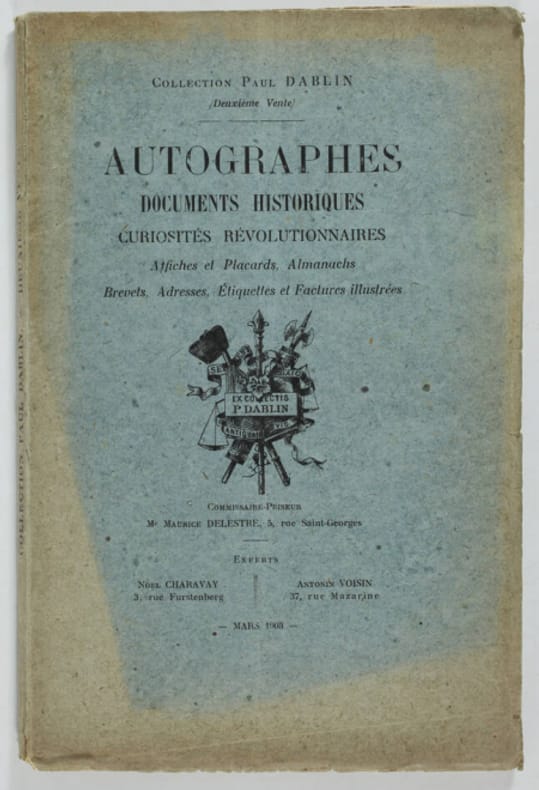
|
|
|
Louis A. Robert
La gerbe mystique
Bel envoi de l'auteur à Maurice Allem, respectueux hommages de l'auteur " Maurice Allem, de son vrai nom Marie Maurice Abel Léon Allemand, né le 5 septembre 1872 à Montagnac et mort le 1ᵉʳ septembre 1959 à Paris, est un philologue, romaniste, historien de la littérature autobiographe et bibliographe français. Il est un spécialiste de la littérature française du XIXᵉ siècle. Table, quatre odes triomphales, le rosaire d'amour, symphonies du cœur mystique, fleurs de vitrail, apothéose. volume in-8, 190x140, broché, 116 pages, en partie non coupées, bel état. Paris René Debresse 1939 ref/18
Riferimento per il libraio : CZC-12935
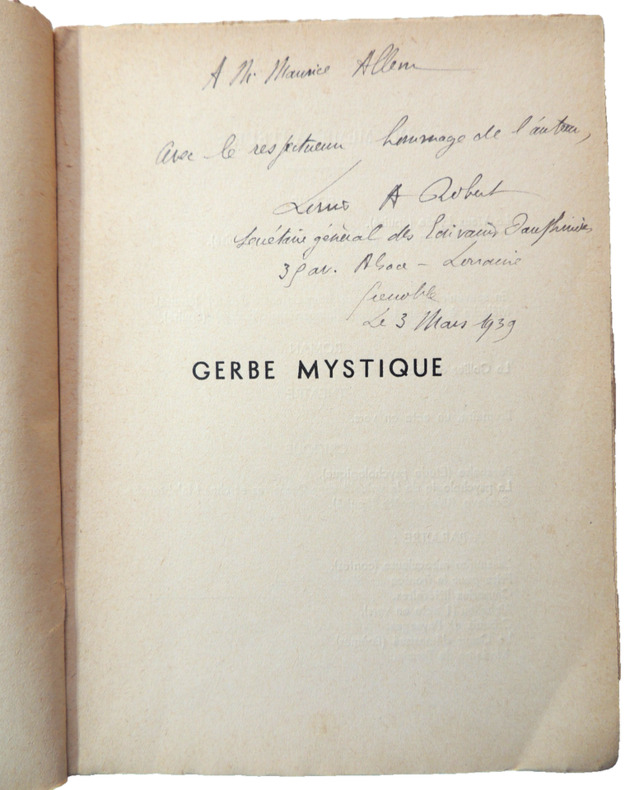
|
|
|
Louis A. Robert
La gerbe mystique
Bel envoi de l'auteur à Maurice Allem, respectueux hommages de l'auteur " Maurice Allem, de son vrai nom Marie Maurice Abel Léon Allemand, né le 5 septembre 1872 à Montagnac et mort le 1ᵉʳ septembre 1959 à Paris, est un philologue, romaniste, historien de la littérature autobiographe et bibliographe français. Il est un spécialiste de la littérature française du XIXᵉ siècle. Table, quatre odes triomphales, le rosaire d'amour, symphonies du cœur mystique, fleurs de vitrail, apothéose. volume in-8, 190x140, broché, 116 pages, en partie non coupées, bel état. Paris René Debresse 1939 ref/18
Riferimento per il libraio : CZC-12935

|
|
|
GRAVURE
Pièce signée par les bibliothécaires Ch. Denina et Barbier. Manuscrit
Paris 30 juillet 1808 in-4 en feuille
Riferimento per il libraio : 19878
|
|
|
LUMIÈRE, Auguste | ENVOI AUTOGRAPHE SIGNÉ
Hérédo-tuberculose
Lyon, Léon Sézanne, 1935, in-8, XV-343 pp, 10 pl, Percaline noire de l'éditeur, Planches en noir, la plupart montrant des radiographies du thorax. Auguste Lumière (1862-1954), que l'on connait bien mieux pour l'invention du cinématographe que pour ses activités de microbiologiste, s'est intéressé à la tuberculose pendant une grande partie de sa carrière. Ses recherches, menées dès les années 1910, le conduisirent à la conclusion - erronée - que la contagion n'était pas le mode habituel de propagation ce cette maladie : selon lui, c'était par la voie de l'hérédité qu'elle se transmettait. La constance avec laquelle il défendit cette théorie, exposée en 1930 dans son ouvrage Tuberculose, contagion, hérédité, lui sera beaucoup reprochée. Toutefois, ses recherches ont permis, indirectement, le dépistage radiographique de nombreux cas de tuberculose familiale, ainsi que le traitement et le suivi des malades. Exemplaire enrichi d'un envoi signé de Lumière, daté d'octobre 1935, au médecin et explorateur Jean Charcot, commandant du Pourquoi-Pas ?. Ex-libris de Jean Rouché. Couverture rigide
Riferimento per il libraio : 83485
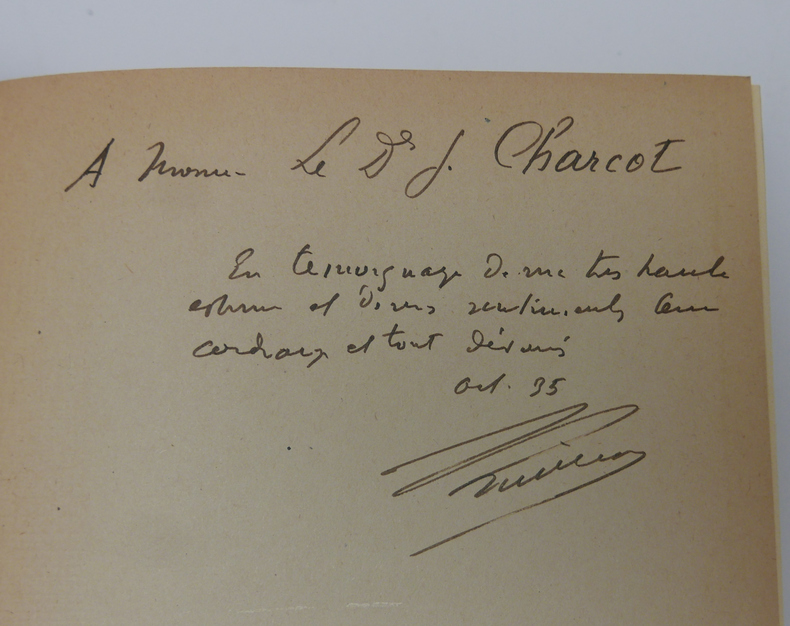
|
|
|
VIGEE-LEBRUN (Louise-Elisabeth)
Lettre autographe signée d'Elisabeth Vigée-Lebrun adressée à une voisine de Meudon.
Un feuillet (262 x 204 mm) plié en deux, 21 lignes à l'encre noire sur papier bleu au recto, adresse et timbre au verso, petit cachet de cire, traces de plis.
Riferimento per il libraio : 39214
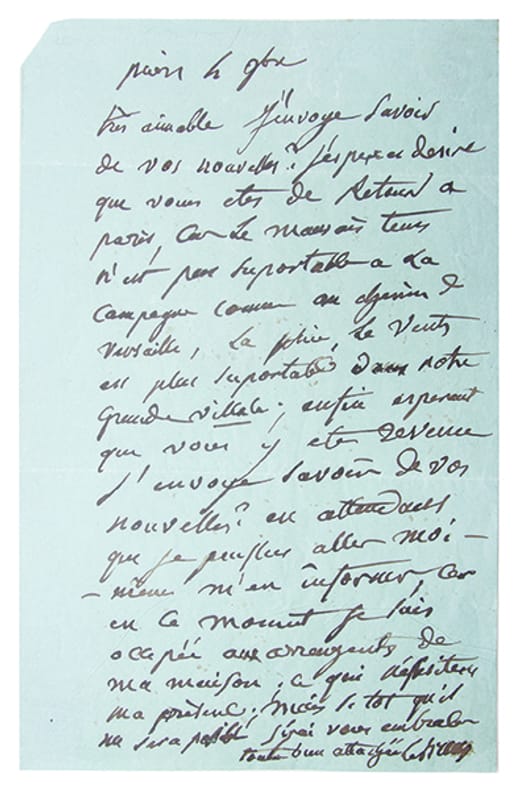
|
|
|
Lucie Wallace
A l'enseigne du gai soleil
avec bandeaux, culs de lampe de la collection Poésie volume in-8, 190x140, 156 pages, bel exemplaire, la page manuscrite est coupée sur le haut ( voir photo), la signature de l'auteure est complète. Edition de la Caravelle 1935 ref/18
Riferimento per il libraio : CZC-12938
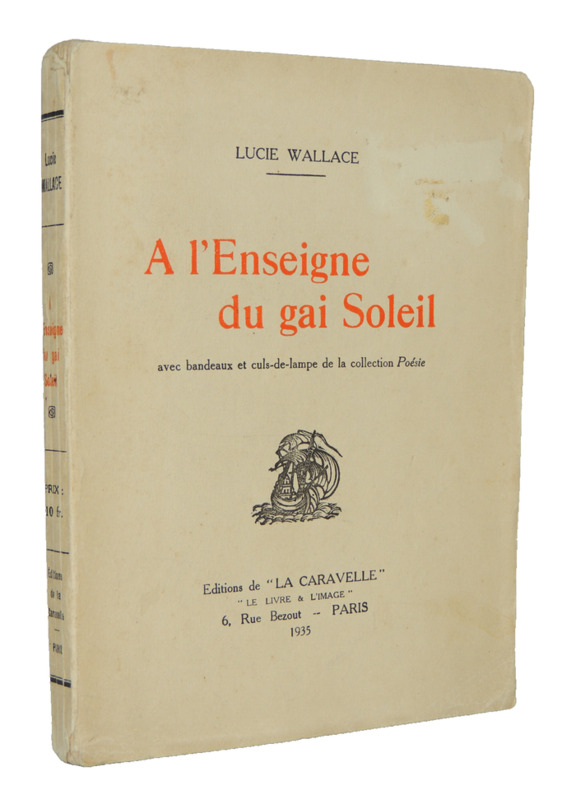
|
|
|
Lucie Wallace
A l'enseigne du gai soleil
avec bandeaux, culs de lampe de la collection Poésie volume in-8, 190x140, 156 pages, bel exemplaire, la page manuscrite est coupée sur le haut ( voir photo), la signature de l'auteure est complète. Edition de la Caravelle 1935 ref/18
Riferimento per il libraio : CZC-12938

|
|
|
FOLLAIN (Jean)
TERRITOIRES Poèmes
Gallimard , Paris, 1953. In--12, broché, 91 pages. Edition originale (après 45 ex. sur pur fil). Exemplaire du service de presse, signature autographe de l'auteur.
Riferimento per il libraio : DQO-509
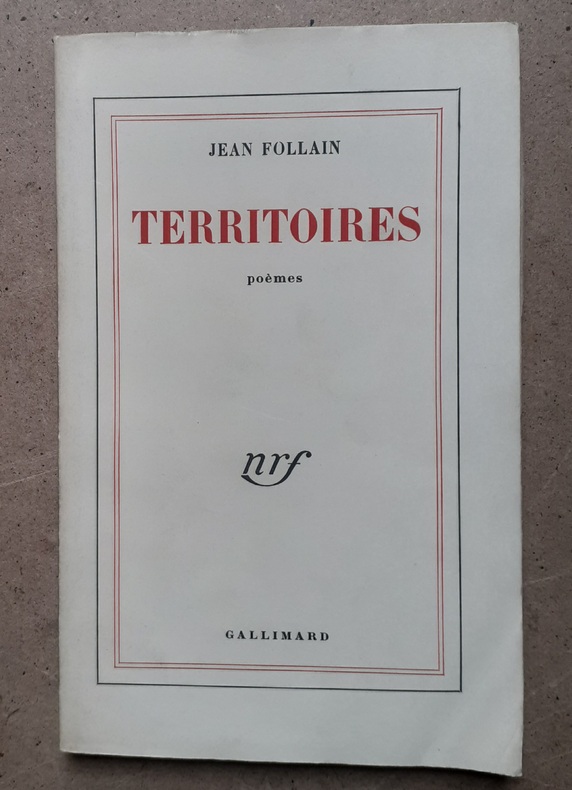
|
|
|
[AUTOGRAPHES]
Album Mariani. Portraits, biographies, autographes. 6e volume.
P., Floury, 1901. In-4 br., n.p., portraits à pleine page.
Riferimento per il libraio : 479108
|
|
|
( Les Nouveaux Mystères de Paris ) - Léo Malet.
Les Nouveaux Mystères de Paris, Nestor Burma à Saint-Germain-des-Prés. Le Sapin pousse dans les Caves. ( Exemplaire avec cordiale lettre autographe, manuscrite, signée par Léo Malet ).
Editions Robert Laffont / " Les Nouveaux Mystères de Paris " n° 4 de 1955. In-12 broché de 222 pages au format 17,5 x 11,5 cm. Belle couverture illustrée. Dos très légèrement gauchi avec petits frottis en haut et en bas. Plats avec petits frottis et tassements aux coins et bords des plats. Tome 4 de cette fameuse série Parisienne mettant en scène Nestor Burma. Bel état général. Edition originale. Précieux exemplaire, enrichi d'une rare et cordiale lettre autographe, manuscrite de 5 lignes, signée par Léo Malet. Lettre pliée en quatre.
Riferimento per il libraio : 18019

|
|
|
( Guerre 1914-1918 ) - Caporal L.Didier.
Emouvant lot de 10 Cartes Postales rédigées et dessinées par un " Poilu ", le Caporal L.Didier, expédiées depuis le Front à son épouse, toutes dédicacées.
Emouvant lot de 2 Cartes Postales maunuscrits et 2 entiérement dessinées par un " Poilu " : le Caporal L.Didier, expédiées depuis le Front à son épouse. Correspondance des Armées de la République, datées de 1915. 2 cartes postales sont une correspondance entre le le Caporal L.Didier et son épouse, les 8 autres sont entièrement illustrées par de superbes dessins originaux, humoristiques, en couleurs signées du pseudonyme de Misti ou Mée. Une d'entre elle, adressée au fils de l'auteur, présente une découpe ou était glissé un brin de violettes. Toutes sont en superbe état, au format 13,5 x 9 cm. Magnifique et émouvant ensemble. De toute rareté.
Riferimento per il libraio : 9431

|
|
|
( Beaux-Arts ) - Carlos Pradal - Sophie Cathala-Pradal.
Présence. ( Tirage unique à 150 exemplaires numérotés, avec une lettre tapuscrite, signée, de l'épouse de l'auteur, Sophie Cathala-Pradal, adressée à l'éditeur Francis Loubatières ).
Toulouse, Editions Sables 1992. In-12 en feuilles, de 23 pages au format 18,5 x 14 cm. Couvertures rempliées, avec vignette de titre collée au 1er plat. Dos carré muet. Plats et intérieur frais. Livre glissé sous une chemise, pleine toile noire, fermée par une tresse en soie. Vignette de titre collée en couverture. Texte inédit sur la peinture par le peintre Carlos Pradal, avec 3 dessins inédits en noir, dont le frontispice. Tirage unique à 150 exemplaires numérotés ( n° 90 ). Etat superbe proche du neuf. Rarissime édition originale. Précieux exemplaire, enrichi d'une lettre tapuscrite, signée, de l'épouse de l'auteur, Sophie Cathala-Pradal, adressée à l'éditeur Francis Loubatières.
Riferimento per il libraio : 11155

|
|
|
( Jazz ) - Gaston Criel - Guy Darol.
Swing + superbe lettre autographe manuscrite, signée, de Gaston Criel.
Samuel Tastet éditeur / Est 1988. In-8 broché de 60 pages au format 13,5 x 21,5 cm. Couverture rempliée avec titre imprimé. Dos resté carré. Plats et intérieur parfaits. Un poème " Jazz " intitulé : Trompette, a été collé en guise d'ex-libris en page de garde. Tirage sur vergé. Préface de Jean Cocteau. Postface de Charles Delaunay. Cahier photos ( artistes de Jazz ) au mlieu de l'ouvrage. Edition originale chez l'éditeur en état proche du neuf. Rare exemplaire auquel on joint une belle lettre manuscrite de l'auteur adressée à son ami Guy Darol, datée de 1976 et rédigé au verso du priére d'insérer d'un livre écrit par Alain Roussel. On joint aussi le texte hommage à Criel écrit par Guy Darol ( Gaston Criel, secrétaire d’André Gide et locataire de Jean-Paul Sartre (moyennant un paquet de Gauloises), assistant de Jean Cocteau sur le tournage de la Belle et la Bête, fut celui qui négocia auprès de Jérôme Lindon la publication du Vieillard et l’Enfant aux Éditions de Minuit.Ce poète et romancier du Paris rebelle et artiste (tautologie, n’est-ce pas ?) connaissait le meilleur des mondes, celui qui s’insurge en fête sans jamais se lasser de remettre l’utopie sur le tapis. Autre temps, dirait-on.Il faillit obtenir le Prix Goncourt pour La Grande Foutaise (un titre qui en dit long sur la cosmogonie de Gaston) et reçut, ce qui est beaucoup mieux, les louanges bien sincères d’Henry Miller, spécialiste en littérature égale de la vie.Gaston Criel est l’auteur d’une œuvre importante (qu’il conviendra un jour de rendre à son public) et d’un livre époustouflant : Swing. Samuel Tastet qui fut son ami s’est toujours démené pour faire tinter le nom de Criel (cri et ciel) aux oreilles de ceux qui aiment vraiment la littérature. Pour la troisième fois, il publie Swing (avec préface de Jean Cocteau et témoignage de Charles Delaunay) par amitié et conviction.Ce livre est en effet une quintessence de haute écriture et, son nom l’indique, l’une des meilleures introductions au jazz.J’eus le bonheur de connaître et de fréquenter Gaston Criel qui partageait des plages d’oisiveté avec Duke Ellington, Charlie Parker, Earl Hines et Mezz Mezzrow sans que l’auteur de Sexaga et de L’Os quotidien ne me fasse sentir comme un décalage d’envergure. Il était demeuré un enfant sans ego, puissamment vivant, joyeusement négligent devant la question du succès qui vient, ne vient pas, tant mieux, tant pis. Admirable Gaston. Celui qui avait été, je l’ai dit, l’ami de Sartre et de Cocteau, me demandait mon avis sur les textes qu’il venait d’écrire. Histoire de bœufs tirés par la charrue.Alors que je collaborais à Libération et que Samuel Tastet faisait paraître, une première fois, son hymne au jazz salué par Francis Picabia, Boris Vian, Frank Ténot…, j’écrivis un éloge de Swing rehaussé de son portrait en aigle bienveillant. Nous étions en juin 1982 et Gaston m’invita sur une terrasse de l’Avenue Foch pour me remercier de mon travail.Nous bûmes et déconnâmes en évoquant Pink Floyd, Frank Zappa et les Stones dont il était un auditeur intense. Voici un événement dont je me rappelle sans une tache d’ombre.Car c’est ainsi que la littérature m’a toujours parlé.Ceux qui écrivent en excellence sont excellents.Autrement dit, joyeux et bons.Tel était Gaston ).
Riferimento per il libraio : 13336
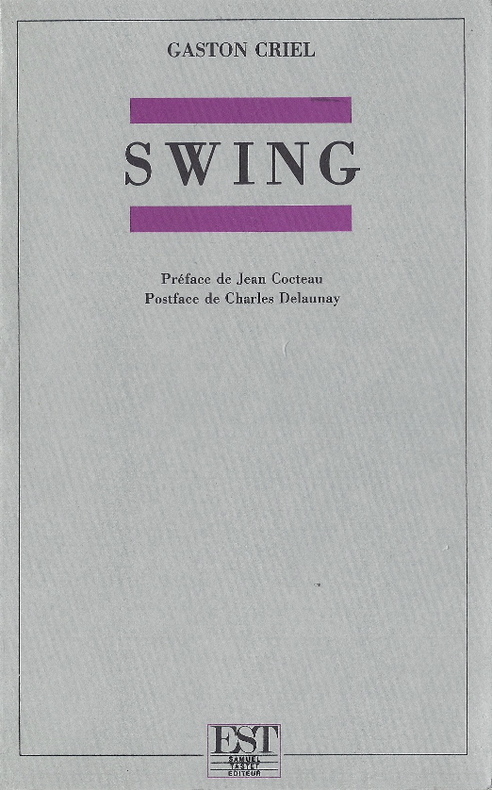
|
|
|
( Cinéma - Claude Sautet ) - Roland Lacourbe - Alain Decaux.
Nazisme et Seconde Guerre Mondiale dans le cinéma d'Espionnage. ( Exemplaire avec superbe lettre manuscrite de Roland Lacourbe à Claude Sautet ).
Editions Henri Veyrier 1983. In-8 broché de 278 pages au format 15 x 23,5 cm. Couverture rempliée avec photographie en noir. Dos bien carré. Plats et intérieur frais. Rousseurs sur les tranches. Présentation de l'auteur avec photo et de l'ouvrage. Préface d'Alain Decaux. Rigoureuse étude sur le nazisme et la seconde Guerre Mondiale dans le cinéma d'Espionnage, accompagnée de très nombreuses photos en noir, hors texte. Edition originale. Précieux exemplaire accompagné d'une très belle lettre manuscrite de 19 lignes de Roland Lacourbe au cinéaste Claude Sautet, avec cachet de l'auteur, en date du 21 septembre 1983. Courrier où Roland Lacourbe demande un rendez-vous à Claude Sautet pour la rédaction d'un ouvrage consacré au metteur en scène. Intéressant document en parfait état. Bel ensemble.
Riferimento per il libraio : 14213
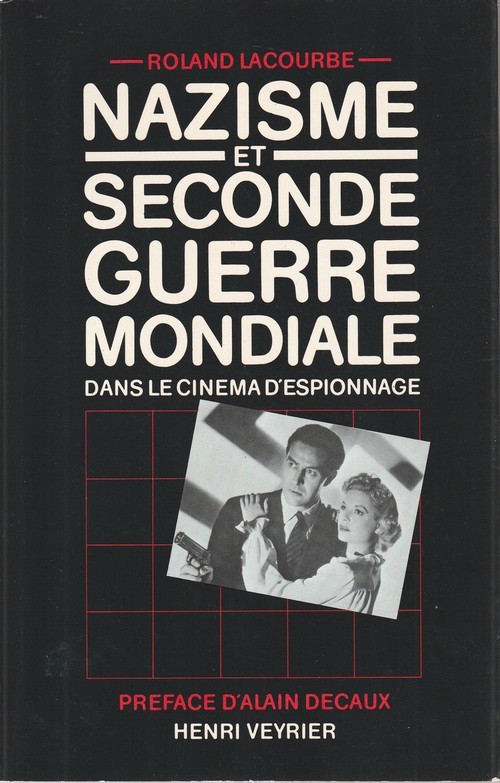
|
|
|
Marcel Schneider.
Le Guerrier de Pierre. ( Précieux exemplaire avec lettre autographe manuscrite signée de Marcel Schneider sous enveloppe ).
Editions Bernard Grasset 1969. In-8 broché de 175 pages au format 12 x 19 cm. Couverture rempliée avec titre imprimé. Dos bien carré. Plats et intérieur frais. Complet de la bande annonce. Exemplaire du service de presse avec papillon d'expédition de l'éditeur. Etat proche du neuf. Edition originale. Précieux exemplaire accompagné d'une lettre autographe manuscrite signée de l'auteur sous enveloppe. Lettre recto verso de 29 lignes, datée et signée du 12 mai 1993.
Riferimento per il libraio : 15544
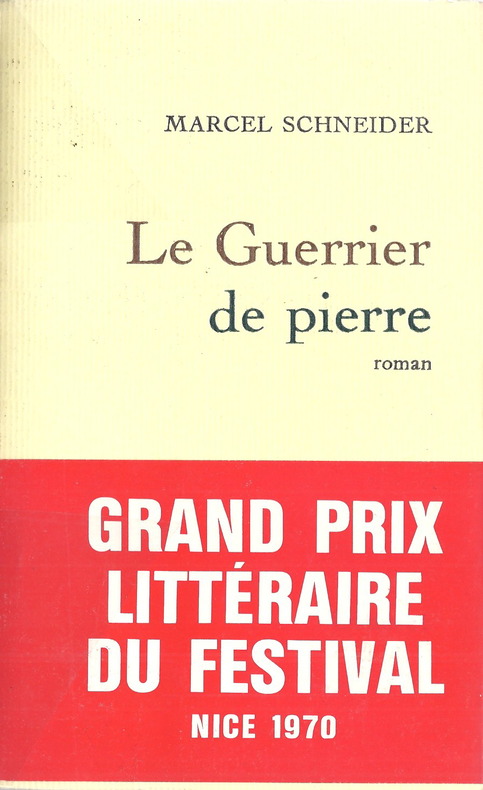
|
|
|
Jacques Faizant - Colonel Jean Vasche
Allez vous rhabiller . ( Avec belle dédicace de Jacques Faizant + 2 lettres autographes signées du Colonel Jean Vasche ).
Editions Calmann-Lévy / Nouvelle Collection Labiche 1961. In-8 broché de 242 pages au format 13 x 19 cm. Couverture illustrée. Dos carré. Plats et intérieur frais. Roman illustré par l'auteur. Exemplaire enrichi d'une cordiale dédicace, autographe, signée de l'auteur au Colonel Jean Vasche. Rare exemplaire accompagné d'une belle lettre manuscrite de 2 pages, sous enveloppe, du Colonel Jean Vasche, où ce dernier sollicite Jacques Faizant en vue d'obtenir un dessin original pour une publication d'une promotion Saint Cyr. On joint la lettre tapuscrite, signée, avec la réponse négative de Jacques Faizant. Superbe et rare ensemble.
Riferimento per il libraio : 26085

|
|
|
( Littérature en Anglais - Littérature dédicacée - Politique Américaine - Reies Lopez Tijerina ). Michael Jenkinson - Karl Kernberger
Tijerina. Land Grant Conflict in New Mexico. ( Premier tirage limité à 1500 exemplaires, dédicacé par Michael Jenkison + lettre autographe ).
Library of Congress Card / Copyright 1968, Ben Pollack - Paisano Press, Station D Box 3353, Albuquerque, New Mexico 87110. In-8 broché de 104 pages au format 22,5 x 14,5 cm. Couverture et photos en noir par Karl Kernberger. Dos carré, un peu insolé. Coins avec infimes frottis et tassements. Intérieur frais. Photo de l'auteur au 4ème plat. Chronique de l'histoire du raid armé de 1967 sur le palais de justice de Tierra Amarilla par Reies Lopez Tijerina (21 septembre 1926 - 19 janvier 2015). Ce dernier qui fut un activiste redouté, mena une lutte dans les années 1960 et 1970 pour restaurer les concessions de terres du Nouveau Mexique aux descendants de leurs propriétaires coloniaux et mexicains espagnols . En tant que porte-parole vocal pour les droits des Hispaniques et des Mexicains américains , il devint une figure majeure du premier mouvement chicano ou " Indohispano " et fonda l' Alianza. Federal de Mercedes. Premier tirage en édition originale, imprimé uniquement à 1500 exemplaires. Très bel état général. Rarissime édition originale, américaine, enrichi d'une dédicace autographe, signée, de Michael Jenkison, ainsi que d'une lettre autographe manuscrite de 3 pages, de l'auteur, sous enveloppe affranchie.
Riferimento per il libraio : 26544

|
|
|
( Littérature en Anglais - Littérature dédicacée ) - Jonathan Latimer.
Black is the Fashion for Dying, a ramdom House Mystery by Jonathan Latimer. ( Avec magnifique dédicace de Jonathan Latimer, accompagnée d'une belle lettre autographe, sous enveloppe, de son épouse " Jo Ann Latimer " ).
Etats-Unis, New York, Random House, Inc, 1959. In-12 cartonnage éditeur, pleine toile noire, de 240 pages au format 14,5 x 21,5 cm. Couverture avec non de l'auteur argenté. Dos rond avec titre. Complet de la jaquette illustrée par Paul Bacon, en superbe état, avec dos un peu insolé, infimes frottis aux coins et petit manque en haut du dos. Belle photographie de l'auteur au 4ème plat. Plats et intérieur frais. Rare édition originale américaine en superbe état de fraicheur. Magnifique et précieux exemplaire enrichi d'une magnifique dédicace autographe, signée de Jonathan Latimer : Hattie and Red Perry, greetings and hopes for martinis and another meeting soon ! + une belle lettre autographe, sous enveloppe, de l'épouse de l'auteur " Jo Ann Latimer " adressée aux mêmes destinataires que ceux de la dédicace de son mari : Dear Hattie and Red, We had much fun being with you and hope you'll come back to La Jolla soon I We had a great time in Las Vegas with Fran. Yesterday we had a big day in Tijuana at the horse races & Jai Lai. She plans to be in LA Jolla another week. We all got cleaned in Las Vegas but what a way to love it. Our weather is quite perfect. I hope you enjoy the book. Its not one of my favourites but the author likes it. Come back soon. Affectionately. Jo Ann. Les dédicaces de Jonathan Latimer sont rares.
Riferimento per il libraio : 27579

|
|
|
Alphonse Boudard.
Cinoche. ( Exemplaire du service de presse avec belle dédicace et superbe lettre autographe de Alphonse Boudard à André Tillieu + article de ce dernier ).
Editions La Table Ronde 1974. In-8 broché de 276 pages au format 20,5 x 14 cm. Couverture avec titre imprimé. Dos très légèrement gauchi. Plats et intérieur frais. Complet de la belle jaquette illustrée. Exemplaire du service de presse. Annotations écrites par le journaliste André Tillieu qui à joint son article de 2 pages sur l'auteur, découpé d'une revue, intitulé " Faire du Cinéma ". Edition originale en superbe état général. Précieux exemplaire enrichi d'une belle dédicace autographe, signée et datée, d'Alphonse Boudard ainsi que d'une superbe lettre autographe, recto-verso à André Tillieu, journaliste, chroniqueur, et écrivain belge. Belle provenance. A noter que dans la lettre, Boudard se plaint de la médiatisation du duel électoral entre Valéry Giscard d'Estaing et François Mitterrand et parle d'un livre de Louis Nucera.
Riferimento per il libraio : 27867

|
|
|
Alphonse Boudard.
L'Hôpital, une Hostobiographie. Roman. ( Avec belle dédicace et lettre autographe, d'Alphonse Boudard à André Tillieu ).
Editions La Table Ronde 1972. In-8 broché de 326 pages au format 20,5 x 14 cm. Couverture avec titre imprimé. Dos carré. Plats et intérieur frais. Exemplaire du service de presse. Annotations et texte au crayon en page de garde, par le journaliste André Tillieu. Edition originale en superbe état général. Précieux exemplaire enrichi d'une cordiale dédicace autographe, signée et datée, d'Alphonse Boudard ainsi que d'une belle lettre autographe, André Tillieu, journaliste, chroniqueur, et écrivain belge. Belle provenance.
Riferimento per il libraio : 27868
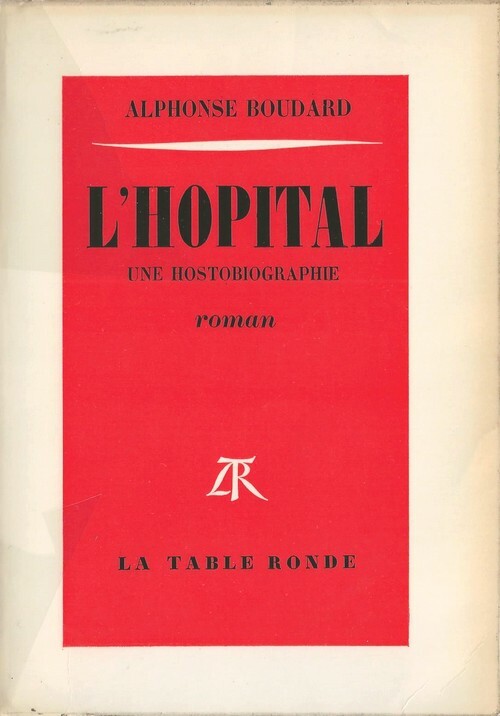
|
|
|
Alphonse Boudard.
Les Enfants de Choeur. ( Exemplaire du service de presse avec superbe dédicace et lettre autographe de Alphonse Boudard à André Tillieu + article et notes de ce dernier ).
Editions Flammarion 1982. In-8 broché de 278 pages au format 20 x 14 cm. Couverture avec titre imprimé. Dos carré. Plats et intérieur frais. Complet de la belle jaquette illustrée avec photo de l'auteur par Robert Doisneau au 1er rabat. Exemplaire du service de presse. Annotations écrites par le journaliste André Tillieu qui à joint un article sur l'auteur, découpé d'une revue, et une feuille avec notes manuscrites. Edition originale en superbe état général. Précieux exemplaire enrichi d'une belle dédicace autographe, signée, d'Alphonse Boudard ainsi que d'une superbe lettre autographe, recto-verso à André Tillieu, journaliste, chroniqueur, et écrivain belge. Belle provenance. A noter que dans la lettre, Boudard parle de Louis Nucera.
Riferimento per il libraio : 27869
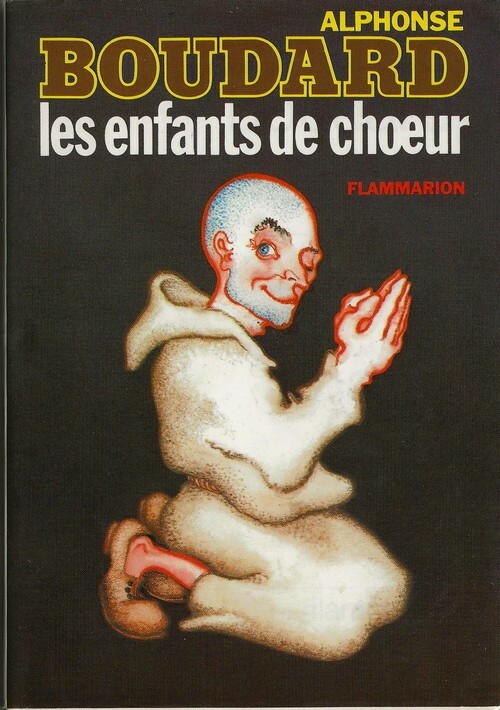
|
|
|
Alphonse Boudard.
Le Corbillard de Jules. ( Exemplaire du service de presse avec belle dédicace et superbe lettre autographe de Alphonse Boudard à André Tillieu + article de ce dernier ).
Editions La Table Ronde 1979. In-8 broché de 251 pages au format 22 x 15 cm. Couverture avec titre imprimé. Dos très légèrement gauchi. Plats et intérieur frais. Complet de la belle jaquette illustrée par Jean-Paul Théodule. Exemplaire du service de presse. Annotations écrites par le journaliste André Tillieu qui à joint son article de 2 pages sur l'auteur, découpé d'une revue, intitulé " Alphonse Boudard : Que vous vous Bidonnassiez... ". Edition originale en superbe état général. Précieux exemplaire enrichi d'une belle dédicace autographe, signée d'Alphonse Boudard aux époux Tillieu ainsi que d'une superbe lettre autographe, André Tillieu, journaliste, chroniqueur, et écrivain belge. Belle provenance. A noter que dans la lettre, Boudard, souhaite retrouver le journaliste et leurs 2 amis communs : Georges Brassens et Louis Nucera.
Riferimento per il libraio : 27870
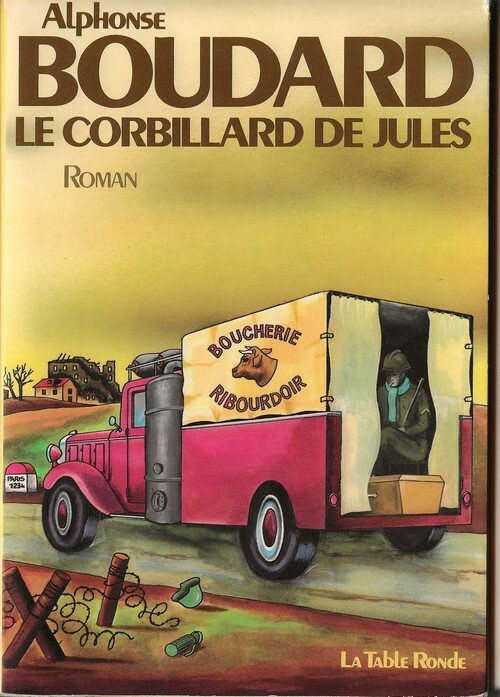
|
|
|